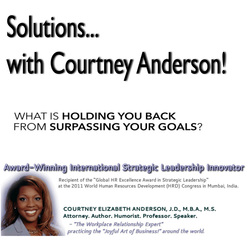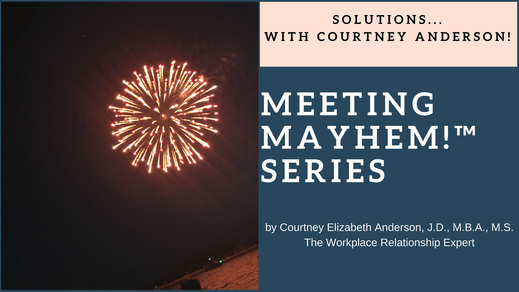RADIO SHOW/AUDIO PODCAST
Solutions...with Courtney Anderson! (SwCA)
MEETING MAYHEM!™ SERIES
ABOUT THE SHOW & SERIES:

What is Holding You Back from Surpassing Your Goals? Business. Legal. Life.
Courtney Elizabeth Anderson, J.D., M.B.A., M.S., is "The Workplace Relationship Expert" ™ (CourtneyAnderson.com) and practices the "Joyful Art of Business!"™ around the world (media expert analysis including Businessweek, MSNBC, Wall Street Journal, FOX News, Cosmopolitan, CNN International, USA Today, CNN - HLN, Christian Science Monitor, HuffingtonPost, and many more..). ”Solutions…with Courtney Anderson”™ is a daily show that delivers pragmatic concepts and tools that will permit you to “Practice the Joyful Art of Business”™ each day! An attorney (Litigation-Mitigation.com is law firm site), Ms. Anderson specializes in serving empowered individuals and entrepreneurs with high caliber, technology based, legal solutions.
This is our series, MEETING MAYHEM!™
Definition of meeting: “a focused interaction of cognitive attention, planned or chance, where people agree to come together for a common purpose, whether at the same time and the same place, or at different times in different places.” (http://www.okstate.edu/ceat/msetm/courses/etm5221/Week%201%20Challenges/Meeting%20Analysis%20Findings%20from%20Research%20and%20Practice.pdf) Meeting Analysis: Findings from Research and Practice by Nicholas C. Romano, Jr. & Jay F. Nunamaker, Jr. - Proceedings of the 34th Hawaii International Conference on System Sciences - 2001
Definition of mayhem: “actions that hurt people and destroy things”
Mayhem. (n.d.). Retrieved December 1, 2014, from http://www.merriam-webster.com/dictionary/mayhem
Why this series?
Meetings are one of the most ubiquitous business and organizational tools in the world.
Who is in meetings?
Everyone:
- “In one sample of 65 CEOs, executives spent roughly 18 hours of a 55-hour workweek in meetings” http://online.wsj.com/articles/SB10001424052970204642604577215013504567548
- Another study, “concluded the average worker actually worked only three days a week, or about 1.5 hours a day, and the rest of the working time was “wasted,” with unproductive meetings heading the list of time-wasters.” http://business.financialpost.com/2012/04/18/how-meetings-kill-productivity/
Where are people in meetings?
Everywhere.
How are people in meetings?
Every way:
- Physically in person
- Virtually by video
- Virtually by phone
- Virtually by online chat
Do meetings cost organizations and individuals?
Everyday in several ways:
- “Most organizations devote 7 percent to 15 percent of their personnel budgets to meetings” - See more at: http://www.shrm.org/hrdisciplines/employeerelations/articles/pages/fewer-meetings-boost-employee-productivity.aspx#sthash.rQMjJtTC.dpuf
- “In terms of cost, no meeting is free. The fully loaded cost of getting a chief executive officer and several vice presidents together for a couple of hours can run into the tens of thousands of dollars.” http://sloanreview.mit.edu/article/the-science-and-fiction-of-meetings/
Is the answer to abolish meetings?
Maybe.
-“[D]ata reveal that not only do too many meetings waste company money but fewer meetings would actually boost employee and organizational productivity.” - See more at: http://www.shrm.org/hrdisciplines/employeerelations/articles/pages/fewer-meetings-boost-employee-productivity.aspx#sthash.rQMjJtTC.dpuf
Maybe not.
-From MIT Sloan, “Employees spend increasing amounts of time in meetings and love to complain about them. But privately they see meetings as a productivity tool -- one that companies can learn to use better.” http://sloanreview.mit.edu/article/the-science-and-fiction-of-meetings/
In the interim, while we face meetings around the world, in person, via phone, via video, via online chat, while standing, while sitting, while walking, in boardrooms, hallways, and everywhere else humans may gather…let’s immediately eradicate the most destructive meetings. The most destructive meetings waste time, talent and resources. They create mayhem and this series is dedicated to stopping them.
How does anyone achieve meeting management mastery level skills without learning how to organize, present and attend meetings?
They don't.
- Again, from The Science and Fiction of Meetings from MIT Sloan, “Although most employees believe that they have above-average meeting-oriented skills, that cannot be so. The reality is that many companies would see significant improvements if employees simply learned some of the basics: when to call meetings, how to prepare an agenda, how to encourage participation and how to manage cultural differences and resolve conflicts.
Given how much organizations invest in meetings, it is surprising how few bother to monitor employee skill levels or keep track of how meetings are being viewed internally.“
Since meetings currently exist, let’s make them effective and banish the mayhem that poor meeting management (from organizers, presenters and attendees) causes! In this series we work through techniques to tame and mitigate meeting mayhem anywhere, any time for anyone!
Can it really be done? Is it possible to eradicate Meeting Mayhem?
Yes.
- “SUCCESSFUL ORGANIZATIONS DO NOT treat meetings as a necessary evil. Instead, they view them as a strategic resource and seek out ways to get the most from them. Rather than accepting meetings as a fact of life, they use them to solve problems and build more competitive organizations.” http://sloanreview.mit.edu/article/the-science-and-fiction-of-meetings/
Our series is here to ensure that individuals and organizations do learn the necessary skills to plan, organize, conduct, present and attend mastery level meetings without mayhem! All of this is in furtherance of our mission to surpass our goals! What is holding you back from surpassing your goals?
Courtney Elizabeth Anderson, J.D., M.B.A., M.S., is "The Workplace Relationship Expert" ™ (CourtneyAnderson.com) and practices the "Joyful Art of Business!"™ around the world (media expert analysis including Businessweek, MSNBC, Wall Street Journal, FOX News, Cosmopolitan, CNN International, USA Today, CNN - HLN, Christian Science Monitor, HuffingtonPost, and many more..). ”Solutions…with Courtney Anderson”™ is a daily show that delivers pragmatic concepts and tools that will permit you to “Practice the Joyful Art of Business”™ each day! An attorney (Litigation-Mitigation.com is law firm site), Ms. Anderson specializes in serving empowered individuals and entrepreneurs with high caliber, technology based, legal solutions.
This is our series, MEETING MAYHEM!™
Definition of meeting: “a focused interaction of cognitive attention, planned or chance, where people agree to come together for a common purpose, whether at the same time and the same place, or at different times in different places.” (http://www.okstate.edu/ceat/msetm/courses/etm5221/Week%201%20Challenges/Meeting%20Analysis%20Findings%20from%20Research%20and%20Practice.pdf) Meeting Analysis: Findings from Research and Practice by Nicholas C. Romano, Jr. & Jay F. Nunamaker, Jr. - Proceedings of the 34th Hawaii International Conference on System Sciences - 2001
Definition of mayhem: “actions that hurt people and destroy things”
Mayhem. (n.d.). Retrieved December 1, 2014, from http://www.merriam-webster.com/dictionary/mayhem
Why this series?
Meetings are one of the most ubiquitous business and organizational tools in the world.
Who is in meetings?
Everyone:
- “In one sample of 65 CEOs, executives spent roughly 18 hours of a 55-hour workweek in meetings” http://online.wsj.com/articles/SB10001424052970204642604577215013504567548
- Another study, “concluded the average worker actually worked only three days a week, or about 1.5 hours a day, and the rest of the working time was “wasted,” with unproductive meetings heading the list of time-wasters.” http://business.financialpost.com/2012/04/18/how-meetings-kill-productivity/
Where are people in meetings?
Everywhere.
How are people in meetings?
Every way:
- Physically in person
- Virtually by video
- Virtually by phone
- Virtually by online chat
Do meetings cost organizations and individuals?
Everyday in several ways:
- “Most organizations devote 7 percent to 15 percent of their personnel budgets to meetings” - See more at: http://www.shrm.org/hrdisciplines/employeerelations/articles/pages/fewer-meetings-boost-employee-productivity.aspx#sthash.rQMjJtTC.dpuf
- “In terms of cost, no meeting is free. The fully loaded cost of getting a chief executive officer and several vice presidents together for a couple of hours can run into the tens of thousands of dollars.” http://sloanreview.mit.edu/article/the-science-and-fiction-of-meetings/
Is the answer to abolish meetings?
Maybe.
-“[D]ata reveal that not only do too many meetings waste company money but fewer meetings would actually boost employee and organizational productivity.” - See more at: http://www.shrm.org/hrdisciplines/employeerelations/articles/pages/fewer-meetings-boost-employee-productivity.aspx#sthash.rQMjJtTC.dpuf
Maybe not.
-From MIT Sloan, “Employees spend increasing amounts of time in meetings and love to complain about them. But privately they see meetings as a productivity tool -- one that companies can learn to use better.” http://sloanreview.mit.edu/article/the-science-and-fiction-of-meetings/
In the interim, while we face meetings around the world, in person, via phone, via video, via online chat, while standing, while sitting, while walking, in boardrooms, hallways, and everywhere else humans may gather…let’s immediately eradicate the most destructive meetings. The most destructive meetings waste time, talent and resources. They create mayhem and this series is dedicated to stopping them.
How does anyone achieve meeting management mastery level skills without learning how to organize, present and attend meetings?
They don't.
- Again, from The Science and Fiction of Meetings from MIT Sloan, “Although most employees believe that they have above-average meeting-oriented skills, that cannot be so. The reality is that many companies would see significant improvements if employees simply learned some of the basics: when to call meetings, how to prepare an agenda, how to encourage participation and how to manage cultural differences and resolve conflicts.
Given how much organizations invest in meetings, it is surprising how few bother to monitor employee skill levels or keep track of how meetings are being viewed internally.“
Since meetings currently exist, let’s make them effective and banish the mayhem that poor meeting management (from organizers, presenters and attendees) causes! In this series we work through techniques to tame and mitigate meeting mayhem anywhere, any time for anyone!
Can it really be done? Is it possible to eradicate Meeting Mayhem?
Yes.
- “SUCCESSFUL ORGANIZATIONS DO NOT treat meetings as a necessary evil. Instead, they view them as a strategic resource and seek out ways to get the most from them. Rather than accepting meetings as a fact of life, they use them to solve problems and build more competitive organizations.” http://sloanreview.mit.edu/article/the-science-and-fiction-of-meetings/
Our series is here to ensure that individuals and organizations do learn the necessary skills to plan, organize, conduct, present and attend mastery level meetings without mayhem! All of this is in furtherance of our mission to surpass our goals! What is holding you back from surpassing your goals?
RELATED TELEVISION TALK SHOWS/
|
EPISODE LIST:2014
|



